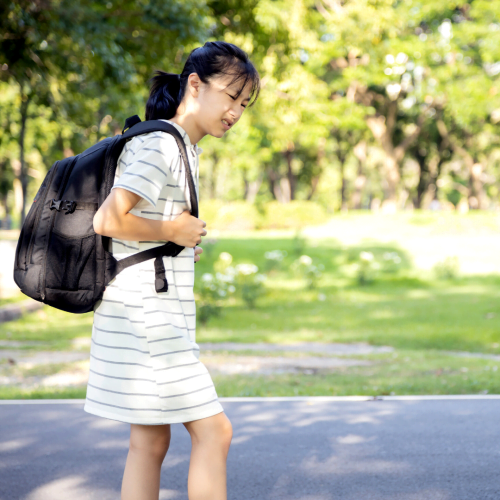
Sling Bag vs. Backpack vs. Luggage Bag: Which One Should I Pick for better bag ergonomics?

Have you ever wondered why your shoulder or back is painful after carrying a bag? Or do you ever wonder if your children are getting the most suitable bags for their posture and growing body? The reason behind this could be due to poor bag ergonomics. Let’s look at 3 different popular types of bags, how they each should be carried properly for optimal bag ergonomics, and what the common problems may be when carrying a bag wrongly.
1) Sling Bag Ergonomics
As we all use our shoulders to carry a bag, let’s start by looking at the normal structure of the shoulder. The shape of the shoulders is that the part that is near the base of neck is usually higher than the tip of the shoulder, so it creates a natural “downslope”. Therefore, when a sling bag is carried only on one shoulder, the tendency is for the bag to slide off the shoulder. In order to stop the bag from sliding, one usually needs to lift up the shoulder on the same side to level the “downslope”. This can eventually leads to overuse of the shoulder and neck muscles, and causes neck pain and stiffness.
The correct way to carry a sling bag and optimise bag ergonomics is to carry it with its strap across the chest. By doing so, the weight of the bag pulls the strap towards the base of the neck (the “cross” effect), instead of slipping off the shoulder. Thus there wouldn’t be a need for the shoulder to elevate excessively. Another benefit of carrying a sling bag across the chest is that the weight can be supported by the hip or back, the downward pull on the shoulder is also lesser, which helps reduce the risk of over-using the neck and shoulder muscles.
2) Backpack Ergonomics
There are many different designs of backpacks. However, they all share one thing in common: there are 2 straps and one on each shoulder. Hence, the bag will not slip off the shoulder easily (as compared to the sling bag). Therefore, there will be less risk of shoulder/neck overuse injury. Speaking of which, that is provided that the bag is indeed carried in the default method: carried on 2 shoulders. If the backpack is carried on one shoulder with only one strap being used, it turns into a “modified sling bag”. This may lead to problems as mentioned above too.
Let’s say now we do carry the bag on both shoulders. Does it mean one will definitely have a correct way of carrying it? The answer is “no”. Have you ever wondered why many parents complain that their school-going kids have terrible posture when they carry their school bags? What went wrong here?
How Should I Carry A Backpack so it doesn’t hurt?
When carrying a backpack, the length of the strap is crucial. If too long, the backpack will “lean backwards” instead of pulling straight “downward”; the backward “leaning” would encourage a body “forward-leaning” or in some people “forward hunching”. This eventually leads to either a much-hunched spine, elevated shoulders, or both; giving rise to many back pain and shoulder problems such as back/shoulder pain or poor posture.
The key is to adjust the length of the strap so that the backpack stays close in contact with the back. If possible, look for bags that have front straps that cross the chest/abdomen for improved bag ergonomics. Such straps can hold the bag closer to the body. The closer and firmer the bag is to the body, the less movement of the bag. As such, the less the body needs to work to carry it with you.
3) Luggage Bag Ergonomics
When it comes to bag ergonomics, pulling a luggage bag is probably easier for the back as the load now is on the ground. Luggage bags have a lesser impact on back posture – be it good posture or poor posture, but they still can result in aches and pain. If the length of the handle is not correctly adjusted, for example, if it’s too short, one needs to turn and bend to the side to pull the bag. This may lead to back strain. On the other hand, if the length of the handle is too long, one would need to excessively lift the shoulder to accommodate the position of the handle. This is also not ideal for one’s posture.
The key here is to ensure the appropriate length of the handle. This is so that when you pull the bag, your shoulder should remain down and relaxed with your elbow bent slightly. There shouldn’t be any turning or side-bending of the trunk too. Last but not least, the weight should not be too heavy to cause possible arm muscle strain. This is especially when the travel time required is long.
Related Articles
- Handbag Ergonomics - Part 1 Musculoskeletal Consumer Review recently caught up with Cheryl Ng, an Associate Principal Physiotherapist at Core Concepts. We were curious about…
- 7 Key Points to Avoid Shoulder Injuries Being on holiday is great fun but have you come back from your holiday with a heavy shoulder? In this…
- HIIT Workouts: Check Your Form (Upper & Lower Body) High-Intensity Interval Training (HIIT) is an increasingly popular and effective way to get lean. HIIT Programmes strip away the…
- BMT Injuries during National Service Enlisting into National Service (NS) is a rite of passage in any Singaporean boy’s youth - some may find it…
- Top 3 posture types leading to back pain You’ve tried pilates and yoga, ergonomic back supports, and back braces, but your chronic back pain persists. So what is…
